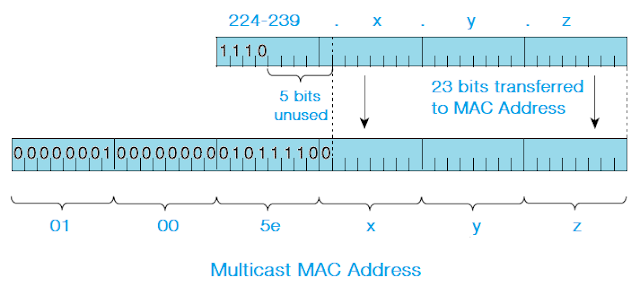IPv4 Multicast Addressing
Routers and switches must have a way to distinguish multicast traffic from the unicast or broadcast traffic. This is done by reserving a dedicated IPv4 Multicast Address Range, 224.0.0.0 through 239.255.255.255, strictly for Multicast Traffic and Services, also known as a IPv4 Class D. Network devices can quickly pick out multicast IP addresses by looking at the four most-significant bits, which are always 1110.
How does a router or switch relate a multicast IP address with a MAC address? There is no Address Resolution Protocol (ARP) equivalent for multicast address mapping. Instead, a reserved Organizationally
Unique Identifier (OUI) value is set aside so that multicast MAC addresses always begin
with 0100.5e (plus the next lower bit, which is zero). The lower 28 bits of the multicast IP address must also be mapped into the lower 23 bits of the MAC address by a simple algorithm.
with 0100.5e (plus the next lower bit, which is zero). The lower 28 bits of the multicast IP address must also be mapped into the lower 23 bits of the MAC address by a simple algorithm.
Multicast IP-to-MAC Address Translation
Below diagram shows the address
mapping concept. Only the lower 23 bits of the address are copied from
IP to MAC (or vice versa). The high-order prefix of both IP and MAC
addresses are fixed, predictable values.

Notice, however, that 5 bits of the IP address are not transferred into the MAC address. This gives the possibility that the multicast MAC addresses are not entirely unique—there are 32 different multicast IP addresses that could all correspond to a single multicast MAC address.
Because of this ambiguity, a multicast host has a small problem when it receives an Ethernet frame destined for a multicast MAC address. That one MAC address could actually correspond to 32 different multicast IP addresses. Therefore, the host must receive and examine every frame that has the MAC address it is interested in—regardless to which of the 32 IP addresses the frame was originally destined. The host must examine the IP header inside each frame to verify that the more specific IP multicast address is a desired multicast group.
Because of this ambiguity, a multicast host has a small problem when it receives an Ethernet frame destined for a multicast MAC address. That one MAC address could actually correspond to 32 different multicast IP addresses. Therefore, the host must receive and examine every frame that has the MAC address it is interested in—regardless to which of the 32 IP addresses the frame was originally destined. The host must examine the IP header inside each frame to verify that the more specific IP multicast address is a desired multicast group.
IPv4 Multicast Address Range
A dedicated IPv4 Class D has been reserved for a running the Multicast services. Some of the IPv4 Multicast Addresses are reserved for a specific use as explained below.
Complete IPv4 Class D range, defined by IANA, is reserved for Multicast: 224.0.0.0 through 239.255.255.255.
Link-Local addresses: 224.0.0.0 - 224.0.0.255. This address range is used by network protocols only on the local network segment. Routers do not forward these packets. These are also known as fixed-group addresses because they are well-known and predefined. TTL for this range Multicast Packets is 1. Below are some examples of reserved Link Local addresses
Link-Local addresses: 224.0.0.0 - 224.0.0.255. This address range is used by network protocols only on the local network segment. Routers do not forward these packets. These are also known as fixed-group addresses because they are well-known and predefined. TTL for this range Multicast Packets is 1. Below are some examples of reserved Link Local addresses
Administratively scoped addresses: 239.0.0.0 - 239.255.255.255. This range of addresses is used in private multicast domains, much like the private IP address ranges from RFC 1918. These addresses are not routed between domains, so they can be reused.
Globally scoped addresses: 224.0.1.0 - 238.255.255.255. These addresses can be routed across an organization or the Internet, so they must be unique and globally significant.
Globally Scoped reserved address range: 224.0.1.0 - 224.0.1.255. This range of addresses are reserved and are routable (TTL>1). Below are few examples:
Network Time Protocol: 224.0.1.1
Globally scoped addresses: 224.0.1.0 - 238.255.255.255. These addresses can be routed across an organization or the Internet, so they must be unique and globally significant.
Globally Scoped reserved address range: 224.0.1.0 - 224.0.1.255. This range of addresses are reserved and are routable (TTL>1). Below are few examples:
Network Time Protocol: 224.0.1.1
Cisco Auto-RP: 224.0.1.39/224.0.1.40






